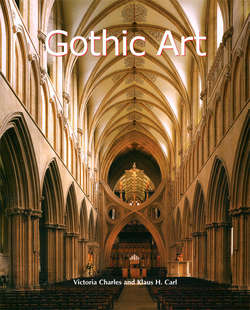Читать книгу Gothic Art - Victoria Charles - Страница 8
Gothic Architecture
Gothic Architectural Monuments
The Gothic in Germany and Austria
ОглавлениеThe oldest major works of the Gothic architectural style in Germany are the choir of Magdeburg Cathedral, which was begun in 1208, the Liebfrauenkirche (Church of Our Lady) in Trier (1227–1243) and the Elisabethkirche (Elisabeth Church) in Marburg (1235–1283). However, these are by no means slavish imitations of the newly arrived French innovation; instead from the very beginning they show much independence in the way they use the foreign forms. For example, despite its French ground plan with an ambulatory and chevet, the choir of Magdeburg Cathedral has national traits in its details. These traits become increasingly pronounced with the building of the longhouse, which was consecrated in 1363. The western façade, too, with its pair of towers completed in 1520, features distinctly national characteristics.
The master builder of the Liebfrauenkirche (Church of Our Lady) in Trier proceeded contrariwise: he only followed the French style in the details, while creating a completely innovative ground plan. Consisting of a centralised building around which a chevet was created, this church is a unique Gothic construction.
The master builder of the Elizabethkirche (Elisabeth Church) worked just as independently. Despite its lengthy construction period, the church appears as a unified whole. The form of the hall church, as it had developed in Westphalia, was retained for the interior’s design. Likewise, the creation of the façade with its slender uninterrupted climbing towers is a deviation from the French type. The master builder had already clearly understood that verticality, i.e. the strong emphasis of the vertical line, represents the most fertile basic Gothic idea.
The Gothic architectural style in Germany, which spread only from the start of the fourteenth century, found its most splendid development in the two cathedrals on the Rhine: Cologne and Freiburg. They were accompanied by three other artistically equally valuable cathedrals, all of which are located at the shores of the Danube: Ulm Cathedral, Regensburg Cathedral in southern Germany and St. Stephen’s Cathedral in Vienna, Austria.
40. Nave, seen from the East, Salisbury Cathedral, Salisbury (United Kingdom), 1220–1258. In situ.
41. Salisbury Cathedral, Salisbury (United Kingdom), 1220–1258. In situ.
St. Peter and Mary Cathedral in Cologne
Cologne Cathedral is the only purely Gothic building. Its long construction period, which lasted over six centuries, did not impair the stylistic consistency. There is something sober about Cologne Cathedral, not only in its conception, but also in its execution. Here, imagination was dominated by reason, the roots of which are buried deeply in basic Gothic principles, which the master builders of Cologne only brought to their final conclusion. Therefore Cologne Cathedral, as it stands, can be seen as a kind of keystone to the entire Gothic architectural period. Here all driving forces of the Gothic converged to bring forth the last hidden seeds of its construction method and to execute the pure principle of verticality, the most essential idea of the Gothic.
Конец ознакомительного фрагмента. Купить книгу
